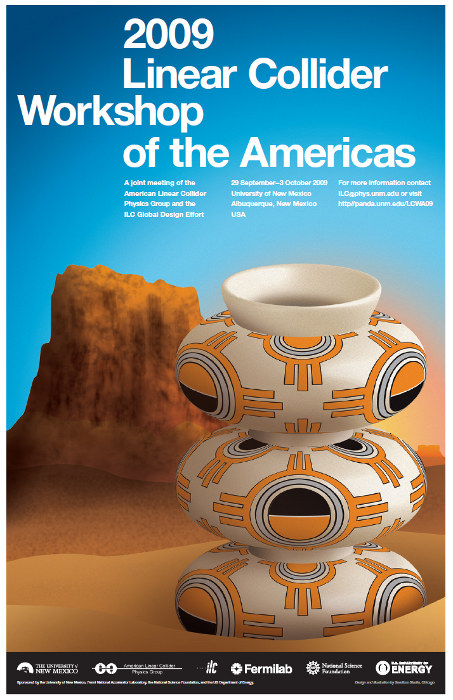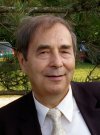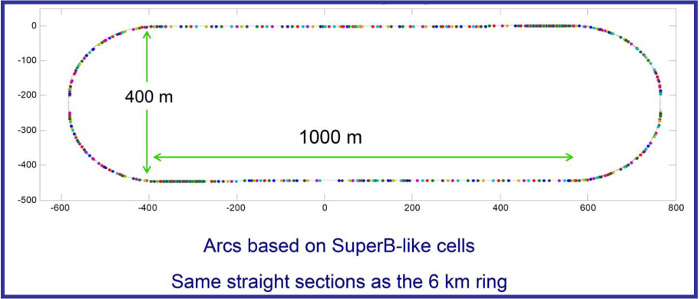Director's Corner
13 August 2009
 Barry Barish |
ALCPG09 in Albuquerque
Both the ILC detector and accelerator communities are dispersed all around the globe. We work together mostly at a distance though extensive use of modern communication tools. Nevertheless, we still must – and do – come together in classical face-to-face meetings to conduct our most important business. Presently, we hold two large meetings a year for the ILC physics, detector and accelerator scientists. These are very busy meetings, consisting of both general plenary sessions, as well as multiple parallel sessions on special topics. Our next such general meeting, organised by the American Linear Collider Physics Group (ALCPG), will be held at the University of New Mexico in Albuquerque, New Mexico from 29 September through 2 October 2009. Next month’s meeting will have special importance to both the ILC detector and accelerator efforts.
 Poster for the Albuquerque ILC meeting Poster for the Albuquerque ILC meeting |
 Michel Davier will give an IDAG report on the detector LOIs at ALCPG09 Michel Davier will give an IDAG report on the detector LOIs at ALCPG09 |
For the past year, a big focus of the ILC detector community has been on developing and now assessing Letters of Intent (LOIs) for three detector concepts. This step represents a major accomplishment in our exercise to better understand the realities of what it will take to make ILC detectors meet the challenging performance required to fully exploit the science of a linear collider. A tremendous amount of very impressive work went into generating the LOIs that were submitted last spring.
The International Detector Advisory Group (IDAG), chaired by Michel Davier, has now undertaken the task of evaluating these LOIs and will soon make their recommendations concerning the validation of these concepts to Sakue Yamada, the ILC Research Director. At the opening plenary session at ALCPG09, we will hear from Michel Davier, who will report on the validation process and the IDAG recommendations. Then, ALCPG09 will represent the first opportunity for post-validation discussions and planning for the next phase of the detector work.
Two years ago at the 2007 ALCPG meeting at Fermilab, the physics discussions were organised around physics signatures, such as: missing energy, jet and photon energy measurements, b/c separation and tau tagging, etc. At ALCPG09, we will again use that successful organisation to bring theorists and experimentalists together for each of these topics to discuss the physics how it can be addressed by the detectors. Two plenary sessions are planned where we will have presentations of physics and benchmark studies, including the simulation studies from the LOI groups on five topics: (1) W/Z separation, (2) recoil mass, (3) Higgs branching fractions, (4) top and tau, and (5) chargino/neutralino measurements.
The accelerator scientists will meet in parallel and in some joint sessions in Albuquerque. The Global Design Effort (GDE) meeting will have special importance for the evolution of the ILC accelerator design. The baseline for the ILC has been stable for the past couple of years and is well documented in the ILC Reference Design Report. That baseline, however, was established to document and cost a viable concept for the ILC, one of which we felt we could demonstrate that it could realistically be built. It was not created through a systematic process of evaluating cost to risk to performance and then making choices, it did not involve much basic value engineering in areas where significant cost savings might be realised, and it picked conservative and perhaps more costly choices in some areas where more work was needed.
Now, we are in the process of doing some of this unfinished work and have chosen a few selected areas where we hope there are potential large cost savings, or will result in a more coherent designs or reduced risks. The process we have undertaken, called the "Accelerator Design & Integration (AD&I)," has the goal to establish a new improved baseline early next year that will then become the basis of our work towards a Technical Design Report (TDR) in 2012.
 AD&I options under consideration that reduce the number of bunches could result in smaller, cheaper damping rings (for example 3 kilometres vs 6 kilometres circumference in the RDR) AD&I options under consideration that reduce the number of bunches could result in smaller, cheaper damping rings (for example 3 kilometres vs 6 kilometres circumference in the RDR) |
At Albuquerque, we will review the proposed baseline changes or "Strawman Baseline 2009" (SB2009) elements. This will involve reports of the ongoing studies and plans towards the new baseline, preliminary assessments of the associated cost increments and that analysis of risks by developing a "risk register." ALCPG09 will also present the opportunity for having discussions with the experimentalists in an open forum of the possible implications of the proposed baseline changes for physics and detectors. Following ALCPG09, we plan to refine the proposed baseline changes, present them to our oversight committees and community, and finally bring then for approval of the broader ILC community at the next large collaboration meeting to be held from 26 to 30 March 2010 in Beijing, China.
In addition to the work on a new ILC baseline at ALCPG09, we will have meetings of our joint working groups with the Compact Linear Collider Study (CLIC), carry out some strategic meetings on how to make the ILC a reality, and we will review key elements of our R&D programme. Topics will include the global high-gradient SCRF programme and TTF/FLASH 9mA experimental run, electron cloud suppression and ultra-small emittance generation in the damping rings (CesrTA, ATF, DAΦNE, etc.) and the ATF2 programme for demonstration of the final focus optics and beam stabilisation. We will also have sessions on technical progress on the engineering design and the machine detector interface, the latter jointly with the experimentalists.
ALCPG09 and the GDE Meeting promises to be a very busy and exciting meeting, and one that should mark the continual progress toward a robust design for both the ILC accelerator and detectors. Detailed plans, the agenda and other information on ALCPG09 can be found at the meeting website. I hope to see you there!
-- Barry Barish